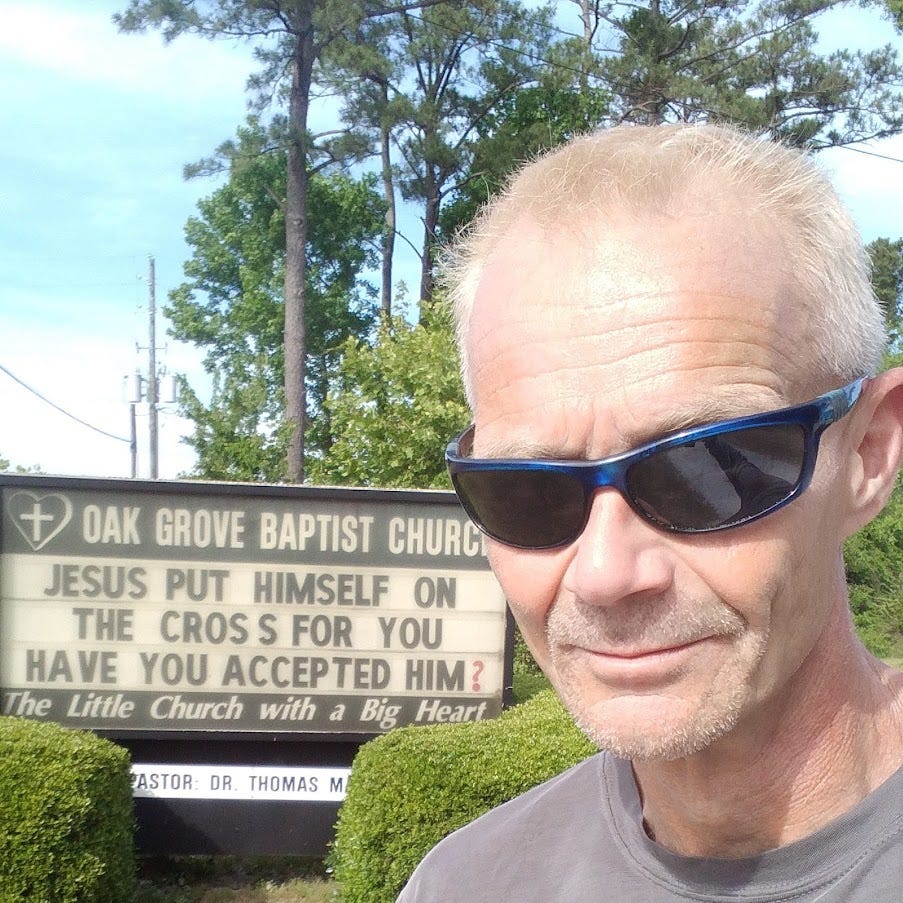Seven is the new six
Dispatches from a study in the carefree expansion of automobile-reliant sprawl
Executive summary: Imagine a group of expert environmental scientists and lawyers getting together, assembling a fantastic project, and violently throwing all the levers in reverse. That's Wilmington, North Carolina, an otherwise nice place to visit where people say “Sorry” for being in your way in grocery stores even when they’re not in the way at all.
Last Tuesday, I flew to Wilmington, North Carolina to visit my parents for a week. Since then, I have largely neglected my PC, explaining my lack of updates of any substance here. And since my neglect of my laptop has meant a sharp decrease in my non-essential Internet activity, I don’t have much in the way of the usual unglamorous substrate kicking around in my head at the moment.
I made the traveling portion as hassle-free as possible by bringing only a backpack containing my laptop, a book, and whatever running clothes and gear I knew I wouldn’t be able to easily replace at the other end by raiding a closet. This is more easily done when travelling to a fair-weather locale like this one, but something I can now accomplish no matter the externalities because I simply change the definition of “required item” as I load the backpack. (I’m working toward slimming this to a fanny pack.) If I travel by air in the future, I will find a way to avoid packing even a carry-on suitcase.
My mom and dad moved from New Hampshire to a place north of town proper (and out of the reach of windstorm-induced flood swells) a few months ago. The nearest main drag is almost a parody of every shitty four-lane state highway that was once barren between adjacent towns, but is now an unbroken sidewalk-free strand of the same eateries, convenience stores, supermarkets, and pro-motoring businesses appearing on similar roads across the country.
This road is worse than most because it’s being widened or otherwise altered as I type, so it’s unwalkable even for a relentlessly busy road with no sidewalks. There is typically no space between the road and the boggy ditch alongside—just occasional driveways leading in and out of strip-mall parking lots and dusty orange-and-white construction-site barrels. No crosswalks, either. Most people observed trying to cross Route 17 on foot look like they might not have anywhere particular to go if and when they make it to the far side, and have probably been to an ABC liquor store recently.
My parents live in a gated community. Ninety-five percent of these communities, in my experience, have just enough security to keep a lazy third-grader from finding an easy way in, and are better at keeping those inside from easily leaving. This is one of them. But it’s new, and pleasant enough.
Rosie is back in Boulder in the care of a friend, so I have now done more than five consecutive runs without a leash in my hand since the fall of 2019. But even without a dog to worry about, if I run from my parents’ place, I’m essentially confined to a single expansive-enough subdivision, because crossing the road to experience a similar subdivision is simply not worth the hassle or outright risk.
I don’t normally time myself on everyday runs mainly because I am almost always running with a dog, but also because I have precisely the mentality of someone who encumbers himself with a dog as often as possible, i.e., I don’t care to know my pace. On those occasional days when I feel like I’m gliding along at low-six-minute pace almost without effort, I prefer to keep this experience untainted by realities that would puncture the illusion. Also, being at 5,300’ elevation just means roughly three percent less speed output for the same work input, so piss on all of it.
But sometimes I like to know what a decent—if still violently non-committal—effort translates to on the ground when I have access to adequate oxygen and unfamiliar roads. Yesterday morning, I ran a little over four miles at 6:40 pace, not looking at my watch the whole time and judging the effort to be somewhat shy of what I could hold for an hour if necessary. It did not feel easy. It was windy, and as a result I was wearing a hoodie (the only thing I brought to cover my torso other than a few T-shirts), but it didn’t feel like any sort of pace I would naturally settle into without conscious effort.
Mechanically, it felt like I remember 6:40 pace feeling like when that was over a minute per mile slower than any applicable race pace. I just have to breathe harder to do it.
According to this resource, to “convert” a performance in a distance event at age 52 to an open-age time, a male runner would multiply his time by 0.8606. Because 6/7 = 0.857, one way to look at this is that when you reach my age, running 7:00 pace is “worth” what running 6:00 pace was when you were least eighteen years younger.
Multiplying 6:40 pace by 0.8608 yields 5:44 pace, and that never would have felt easy to me for a four-mile random run even when I was capable of running that fast for more than two hours. Taking the data-supported ghastliness of the aging process into consideration, I should have felt practically tapped by this run.
The good news is that it just gets easier over time to get in a solid running workout without actually moving my arms and legs very much. The bad news is how ugly things would look if I decided to start racing again, even if things went well.
An 18:00 5K at my age is allegedly worth about 15:29 for an open-age runner. I ran a little faster than that, but it’s about what I would usually run while fit and not inclined to quit trying in mile three because I held either a large lead or a large deficit. And it took more than the daily hour or so of jogging around I’ve been doing for a few years now to get there. I really can’t envision a world in which it makes sense to accept a 5K time starting with 17 as a job well done, and, applying that to every other distance I might be inclined to try, I can’t see getting out there again and being anything other than irate at the result. I have enough sources of everyday aggravation as it is, and plenty of other signs that my biological vessel is grinding messily toward its inevitable cessation of activity, albeit more slowly than I’d like.
Despite the unbearable nature of this meta-revelation, my visit has been even more fun than I hoped, and I was expecting good things. I have a proxy dog to keep me occupied (and alert; Harper is a fifth-degree counter-surfer). On Wednesday, we went to a Japanese restaurant where hibachi is prepared conspicuously and using rapid knifeplay, and yesterday included a trip to the Cape Fear Museum.
But if I decided to stay, it might not work because the preferred look for men of most any age, including eight, is to sport a shaved head and a beard at the same time. When someone my size does this—and many around here do—the result looks like a lumberjack on a hunger strike, or a trucker so intent on driving and popping bennies that he has not eaten since two time zones ago. I can only imagine what one of these guys visiting his parents in Boulder, what with its yoga pants, spandex, and shaved legs inside Nissan Leafs, would think while tooling about town in his or her rented Humvee.








